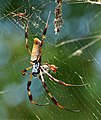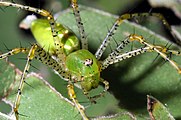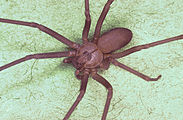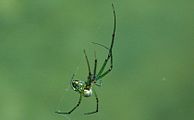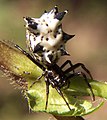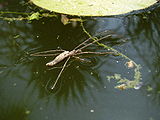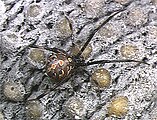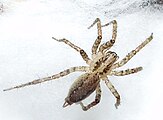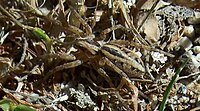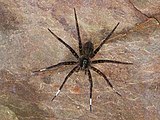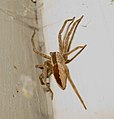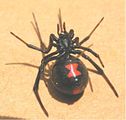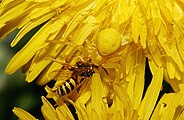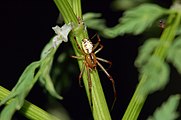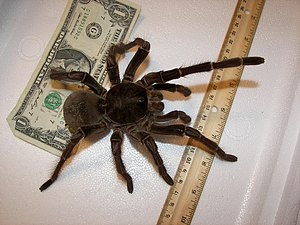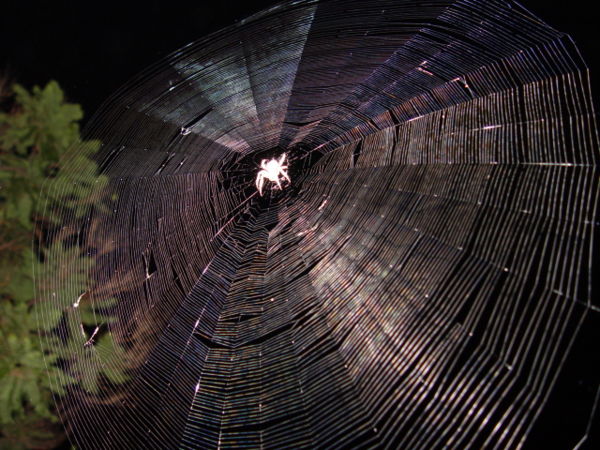Difference between revisions of "AY Honors/Spiders/Answer Key/es"
(Created page with "</noinclude> <!-- 7. ¿Qué comen las arañas? Hacer una lista de las víctimas que se encuentran en las telarañas. -->") |
(Created page with "Estas son algunas de las cosas que comen las arañas. Acepte todas las respuestas razonables para la primera pregunta. Moscas, Saltamontes, Avispas, Abejas, Mosquitos, Geckos,...") |
||
| Line 133: | Line 133: | ||
<!-- 7. ¿Qué comen las arañas? Hacer una lista de las víctimas que se encuentran en las telarañas. --> | <!-- 7. ¿Qué comen las arañas? Hacer una lista de las víctimas que se encuentran en las telarañas. --> | ||
| − | + | Estas son algunas de las cosas que comen las arañas. Acepte todas las respuestas razonables para la primera pregunta. | |
| − | + | Moscas, | |
| − | + | Saltamontes, | |
| − | + | Avispas, | |
| − | + | Abejas, | |
| − | + | Mosquitos, | |
Geckos, | Geckos, | ||
| − | + | Lagartijas, | |
| − | + | Otras arañas | |
| − | + | Insectos, | |
| − | + | Serpientes, | |
| − | + | Pájaros pequeños, | |
| − | + | Ratones, | |
| − | + | Ranas, | |
| − | + | Peces pequeños, | |
| − | + | Renacuajos, | |
| − | + | Grillos, | |
| − | + | Escarabajos, | |
| − | + | Gusanos, | |
| − | + | cucarachas | |
Locate a web either at the location of the meeting or have each student watch one near their home. Write down what they see caught in the web. | Locate a web either at the location of the meeting or have each student watch one near their home. Write down what they see caught in the web. | ||
Revision as of 23:53, 28 February 2021
| Arácnidos | ||
|---|---|---|
| Asociación General
|
Destreza: 2 Año de introducción: 1928 |
|
Requisitos
1
Debido a que ahora hay muchas especies de arañas en peligro de extinción, es posible que desee animar por la selección de las opciones b ó c.
1a
1b
Aquí están algunas fotografías de varias arañas que puede dibujar.
1c
Si su cámara tiene un modo macro, asegúrese de usarlo cuando tome fotografías en primer plano. Esta característica está marcada con un símbolo de una flor en muchas cámaras. La mayoría de las cámaras no pueden enfocarse en objetos cercanos a menos que estén en el modo macro.
Para identificar las arañas que encuentre, es posible que tenga que consultar una guía de campo. Si desea desarrollar también la especialidad de Insectos, seleccione una guía que cubra arañas e insectos.
2
La tarántula Goliat (también llamado la tarántula gigante o tarántula pajarera) ( Theraphosa blondi) es un arácnido que pertenece a la familia de tarántula y es la araña más grande en el mundo. La araña fue nombrada por los exploradores de la época victoriana, quienes fueron testigos de ver una comerse un colibrí y reportaron lo que vieron al mundo occidental.
La más grande que se ha encontrado tenía una largura de patas más de 28 cm.
3
La araña dependerá de dónde usted vive. Use los recursos sugeridos y su biblioteca local para los libros sobre las arañas de su área. También es posible usar un buscador por internet y buscar algo así como «araña notoria» y el nombre de su región, país o continente.
4
Las arañas tienen 8 patas mientras que los insectos sólo tienen 6.
Las arañas tienen ojos con lentes singulares e insectos tienen ojos compuestos.
Las arañas no tienen antenas y los insectos sí.
Las arañas tienen cuerpos con dos partes: la cabeza y el tórax combinados se llama el cefalotórax, y el abdomen; los insectos tienen cuerpos con tres partes: la cabeza, el tórax y el abdomen.
5
6
Telarañas de embudo y en forma de hoja por las arañas de hierba, de la familia Agelenidae. La tela en forma de hoja se usa para atrapar a sus presas, mientras que la araña se esconde en el embudo para el momento justo que sale para atrapar la víctima indefensa.
Telarañas con forma de carpa, que se utiliza como un vivero o un nido especial llevado alrededor por la hembra hasta que los huevos están a punto de salir del cascarón, tejida por la familia Pisauridae.
Telarañas irregulares tejidas por las arañas de la familia Theridiidae.
7
Estas son algunas de las cosas que comen las arañas. Acepte todas las respuestas razonables para la primera pregunta. Moscas, Saltamontes, Avispas, Abejas, Mosquitos, Geckos, Lagartijas, Otras arañas Insectos, Serpientes, Pájaros pequeños, Ratones, Ranas, Peces pequeños, Renacuajos, Grillos, Escarabajos, Gusanos, cucarachas
Locate a web either at the location of the meeting or have each student watch one near their home. Write down what they see caught in the web.
8
- Cross hairs for optical instruments. (Gun sights, microscopes, telescope finder scopes)
- Birds use webs for constructing nests.
- Spider webs can be used to cover an injury and help the blood to clot.
- Scientists are experimenting with using spider webs in repairing torn human ligaments.
9
Here are three possibilities:
So are the paths of all that forget God; and the hypocrite’s hope shall perish:
Whose hope shall be cut off, and whose trust shall be a spider’s web.
He shall lean upon his house, but it shall not stand: he shall hold it fast, but it shall not endure.
There be four things which are little upon the earth, but they are exceeding wise:
The ants are a people not strong, yet they prepare their meat in the summer; The conies are but a feeble folk, yet make they their houses in the rocks; The locusts have no king, yet go they forth all of them by bands;
The spider taketh hold with her hands, and is in kings’ palaces.
Behold, the LORD’S hand is not shortened, that it cannot save; neither his ear heavy, that it cannot hear:
But your iniquities have separated between you and your God, and your sins have hid his face from you, that he will not hear. For your hands are defiled with blood, and your fingers with iniquity; your lips have spoken lies, your tongue hath muttered perverseness. None calleth for justice, nor any pleadeth for truth: they trust in vanity, and speak lies; they conceive mischief, and bring forth iniquity. They hatch cockatrice’ eggs, and weave the spider’s web: he that eateth of their eggs dieth, and that which is crushed breaketh out into a viper.
Their webs shall not become garments, neither shall they cover themselves with their works: their works are works of iniquity, and the act of violence is in their hands.
10
Due to excessive habitat destruction, man is the spider's worst enemy.
Round worms and mites are parasites that attach themselves to the spiders, sucking them dry of their vital fluids.
Birds enjoy tasty spider snacks, as do lizards, wasps, and other spiders.
Almost every small carnivore is the spider's enemy.
11
- Emphasize that even though there are some poisonous spiders, except for a few rare cases, they bite humans only in self-defense. The human race needs spiders in order to survive.
11a
Spiders are predators and so they eat flies and other small annoying insects. Many of these insects destroy our crops and gardens. Other insects caught in their webs can cause disease in humans.
Dust mites live in our homes and eat the dead skin that comes off our bodies. Many people are allergic to dust mites. Spiders eat the Dust Mites, thereby assisting in allergen control.
Spiders are an integral part of the food chain. Because the spider eats and is eaten, it helps to keep the ecosystem balanced. Without spiders the ecosystem would become imbalanced, seriously damaging many living things, including humans.
11b
Some spiders are venomous. Their bites can range from painful to deadly if the correct treatment is not used within a short time after the bite.
Most people are afraid of spiders, so if a property has either too many spiders or poisonous spiders, it would be hard to sell that property.
Spiders make webs in unwelcome places, like corners of rooms or between limbs of trees over a path. These webs cause us to spend time and money removing them. Their webs also trap dust that can cause an allergic reaction in some people.
References
http://www.cirrusimage.com/spider.htm
http://www.explorit.org/science/spider.html
http://www.everythingabout.net/articles/biology/animals/arthropods/arachnids/spiders/index.shtml
http://www.ezprezzo.com/crazypics/spider_eats_snake.html
http://cybersleuth-kids.com/sleuth/Science/Animals/Arachnids/Spiders/index1.htm
http://sciencebulletins.amnh.org/biobulletin/biobulletin/story991.html
About the Author
Stephanie East
Educator with a Master's in Education with an Outdoor Education emphasis
Elementary, Middle School & High School Teacher
Corporate Computer Trainer
Co-Director of Wilderness Adventure Camp for the Illinois Conference of Seventh-day Adventists
Co-Creator with Rodney East of "Why Knot? an introduction to knots, splices & rope" DVD which has all the information needed to complete the Knot Tying Honor. Available through Advent Source.
- Categoría: Tiene imagen de insignia
- Adventist Youth Honors Answer Book/Honors/es
- Adventist Youth Honors Answer Book/es
- Adventist Youth Honors Answer Book/Skill Level 2/es
- Categoría: Libro de respuestas de especialidades JA/Especialidades introducidas en 1928
- Adventist Youth Honors Answer Book/General Conference/es
- Adventist Youth Honors Answer Book/Nature/es
- Adventist Youth Honors Answer Book/Nature/Primary/es
- Adventist Youth Honors Answer Book/Stage 0/es
- Adventist Youth Honors Answer Book
- Adventist Youth Honors Answer Book/Do at home


